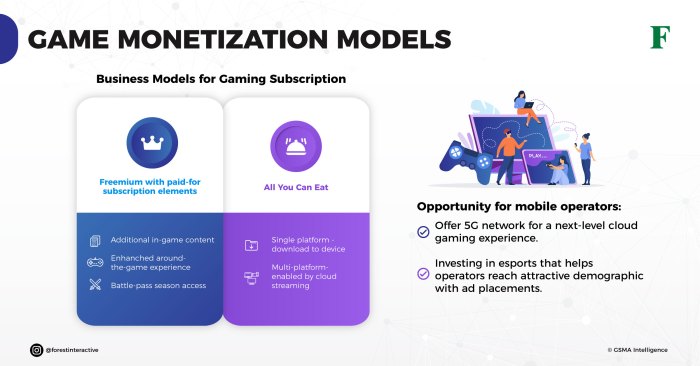
Ever wondered how your favorite games stay free (or afford those stunning graphics)? It’s all about game monetization – the art and science of making money from virtual worlds. From the subtle allure of in-app purchases to the strategic placement of ads, we’re diving deep into the fascinating world of how game developers fund their creations and keep players hooked.
Prepare to uncover the secrets behind successful game economies!
This exploration will cover a wide spectrum of monetization strategies, from classic one-time purchases to the complex ecosystems of free-to-play games. We’ll examine the pros and cons of various models, dissect successful examples, and even delve into the ethical considerations surrounding potentially addictive mechanics. Get ready for a thrilling ride through the financial landscapes of the gaming industry!
Overview of Game Monetization Models

Game developers employ a variety of strategies to generate revenue from their creations. Understanding these monetization models is crucial for both developers aiming to create successful games and players seeking to understand the economics behind their favorite titles. The choice of model often depends on the game’s genre, target audience, and overall design.
Game Monetization Model Types
Several distinct models exist, often used in combination. Each offers a different balance between upfront cost for the player and ongoing revenue for the developer. A well-chosen monetization model can significantly impact a game’s success and longevity.
| Model Name | Description | Pros | Cons |
|---|---|---|---|
| Free-to-Play (F2P) with In-App Purchases (IAP) | The game is free to download and play, but offers optional in-game purchases for cosmetic items, power-ups, or virtual currency. | Large potential player base, potential for high revenue through microtransactions. | Can lead to pay-to-win scenarios if not carefully balanced, potential for player frustration with aggressive monetization. Requires careful design to avoid alienating free players. |
| Premium | Players pay a one-time fee to purchase the full game. No further payments are required. | Clear pricing, avoids potentially negative player perceptions associated with IAPs. Allows for a more focused development experience. | Smaller potential player base compared to F2P, revenue is limited to initial sales. Requires a high-quality product to justify the price. |
| Subscription | Players pay a recurring fee for access to the game’s content, often including exclusive features or benefits. | Provides a steady stream of revenue, encourages player retention through ongoing engagement. | Requires consistent content updates to maintain player interest, potential for player churn if value isn’t perceived. |
| Freemium | A hybrid model combining elements of free-to-play and premium. A basic version of the game is free, while additional content or features are available through in-app purchases. | Balances accessibility with monetization opportunities. | Can be challenging to balance free and paid content effectively. Requires careful consideration of player experience and monetization strategies. |
| Advertising | Revenue is generated through displaying advertisements within the game. This can be integrated into gameplay or displayed during loading screens. | Relatively simple to implement, can generate revenue from a large player base. | Can be disruptive to gameplay, may negatively impact player experience if overdone. Revenue per player is generally lower compared to other models. |
Examples of Monetization Models in Action
The success of a monetization model heavily depends on its implementation. Let’s look at some examples:* Free-to-Play (F2P) with IAP: Candy Crush Saga and Pokémon Go are prime examples. Both games are free to download, but offer in-app purchases for extra lives, power-ups, and other advantages.* Premium: The Legend of Zelda: Breath of the Wild and Red Dead Redemption 2 are successful examples of premium games.
Players pay a one-time fee for the complete experience.* Subscription: Fortnite’s battle pass system operates as a form of subscription model, providing players with ongoing content and rewards for a recurring fee. Many massively multiplayer online role-playing games (MMORPGs) also utilize subscription models.* Freemium: Clash of Clans exemplifies the freemium model. The core game is free, but players can purchase resources or cosmetic items to progress faster.* Advertising: Many casual mobile games utilize advertising as a primary monetization strategy, often displaying ads between levels or during gameplay.
Free-to-Play (F2P) Models

Free-to-play (F2P) games have revolutionized the gaming industry, offering players access to vast digital worlds without upfront costs. This accessibility, however, necessitates clever monetization strategies to ensure the game’s continued development and profitability. This section delves into the various revenue streams and design considerations crucial for successful F2P game development.Free-to-play models rely on a variety of revenue streams to generate income.
The effectiveness of each stream varies greatly depending on the game’s genre, target audience, and overall design. A well-balanced approach often combines several methods to maximize revenue and player satisfaction.
In-App Purchases (IAPs)
In-app purchases represent a cornerstone of F2P monetization. They encompass a wide range of offerings, from cosmetic items enhancing visual appeal to powerful gameplay enhancements granting significant advantages. Examples include virtual currency for acquiring in-game assets, premium characters with unique abilities, and time-saving boosts accelerating progression. The design of IAPs is critical; offering a compelling mix of desirable but non-essential items encourages spending without feeling coercive.
Games like “Candy Crush Saga” masterfully utilize this model, offering boosters and extra lives for purchase, significantly enhancing the gameplay experience for players willing to spend. Careful consideration must be given to pricing and the perceived value of each purchase to optimize conversion rates.
Advertising Revenue
Integrating advertisements into the F2P experience provides another significant revenue stream. These ads can take various forms, including banner ads displayed during gameplay, interstitial ads shown between levels or game sessions, and rewarded video ads offering in-game rewards for watching advertisements. While ads can generate substantial income, they must be carefully implemented to avoid negatively impacting the player experience.
Too many intrusive ads can lead to player frustration and churn. Games successfully integrating ads often offer rewarded video ads as a player-optional way to gain advantages, balancing monetization with user experience. “Subway Surfers,” for instance, demonstrates a skillful integration of rewarded video ads, allowing players to earn extra coins or power-ups in exchange for watching short video clips.
Subscription Models
Subscription models offer players access to premium content or features for a recurring fee. This could include exclusive in-game items, ad-free gameplay, or access to special events and content. Subscription models offer a predictable and consistent revenue stream, providing developers with greater financial stability. However, they require offering substantial value to justify the ongoing cost for players.
Examples include monthly subscriptions that unlock all in-game content or provide regular cosmetic updates, as seen in some massively multiplayer online role-playing games (MMORPGs). The success of a subscription model hinges on offering compelling ongoing value that keeps players engaged and willing to pay for the premium experience.
Balancing Gameplay and Monetization
The delicate balance between engaging gameplay and effective monetization is paramount in F2P games. Overly aggressive monetization tactics can alienate players, while insufficient monetization can hinder the game’s long-term sustainability. A successful F2P game creates a compelling core gameplay loop that is enjoyable even without spending money. Monetization elements should enhance, not disrupt, this core experience. Players should feel that any purchases are optional and enhance their enjoyment, rather than being necessary for progression.
Games that prioritize a fair and balanced approach, such as “Pokémon GO,” where in-app purchases are largely cosmetic or provide minor convenience improvements, often achieve greater success and player loyalty. Games that feel pay-to-win, where significant advantages are locked behind significant paywalls, generally receive negative player feedback and limited longevity.
Premium Models
The premium game model, also known as the “buy-to-play” model, represents a classic approach to game monetization. In this model, players purchase the game upfront for a one-time fee, granting them full access to all content without further costs. This contrasts sharply with the free-to-play model, offering a different player experience and developer strategy.Premium games offer a compelling alternative to the often-criticized free-to-play model’s reliance on in-app purchases and microtransactions.
They promise a complete and polished experience from the outset, free from the interruptions and potential paywalls that can disrupt gameplay. However, this straightforward approach also presents unique challenges for developers.
Advantages and Disadvantages of the Premium Model
The premium model boasts several key advantages. Firstly, it provides a clear and upfront pricing structure, allowing players to make informed decisions before purchasing. This transparency builds trust and reduces the potential for frustration caused by unexpected costs. Secondly, the lack of in-game purchases allows developers to focus on creating a complete and engaging experience, without the need to balance gameplay with monetization strategies.
This can lead to higher-quality games with a greater sense of polish and completion. Finally, premium games often enjoy a more dedicated and engaged player base, as players have invested financially in the game, fostering a stronger sense of ownership and loyalty.However, the premium model also has significant disadvantages. The primary challenge is the inherent risk involved in upfront investment.
Players are less likely to purchase a game they haven’t tried, leading to a higher barrier to entry and potentially lower sales compared to free-to-play titles. Furthermore, the upfront cost can limit the potential player base, excluding players with limited budgets or those hesitant to commit financially without a trial period. Finally, the success of a premium game is heavily reliant on the initial reception and word-of-mouth marketing, as there are fewer opportunities for organic player growth after launch.
Pricing Strategies and Their Impact
The price point of a premium game is a critical factor in its success. Pricing too high risks alienating potential players, while pricing too low may undervalue the game and limit profitability. Several factors influence optimal pricing, including game length, complexity, genre, and target audience. For example, a short, simple mobile game might be priced lower than a complex, story-rich RPG.
Successful pricing often involves market research and analysis of competitor pricing to find a sweet spot that balances profitability with accessibility. A/B testing different price points can also provide valuable insights. Consider the impact of regional pricing strategies, adapting prices to reflect differing purchasing power in various markets.
Examples of Successful Premium Games and Their Pricing Models
Minecraft, a sandbox game known for its open-ended gameplay, initially launched with a relatively low price point, making it accessible to a wide audience. This broad appeal contributed significantly to its immense success. The price remained consistent for a considerable time, building a strong player base. Its enduring popularity showcases the effectiveness of a well-chosen, stable price for a compelling game.Another successful example is Stardew Valley, an indie farming RPG.
Its initial price point was strategically positioned to be competitive within its genre while reflecting the game’s considerable depth and content. This approach, coupled with overwhelmingly positive reviews, established a strong reputation that drove sales and sustained long-term popularity. The consistent price and positive word-of-mouth marketing contributed to its ongoing success.
Hybrid Models
Hybrid monetization models cleverly blend the strengths of both free-to-play (F2P) and premium models, aiming to maximize player acquisition and revenue. They offer a compelling entry point for players while also providing opportunities for substantial in-game purchases. This approach caters to a broader audience, accommodating both players who prefer a one-time purchase and those who enjoy the ongoing engagement of F2P games.Hybrid models typically involve a base game purchase, offering a complete core experience, augmented by optional in-app purchases (IAPs) for cosmetic items, expanded content, or convenience features.
This strategic combination addresses the limitations of purely F2P or premium models, resulting in a more sustainable and potentially lucrative monetization strategy.
Examples of Hybrid Models and Their Effectiveness
Several successful games exemplify the effectiveness of hybrid monetization. For instance, Hades, a critically acclaimed rogue-lite, uses a premium model for its base game, providing a complete and satisfying experience. However, it also offers optional cosmetic upgrades through IAPs, enhancing the visual customization without impacting gameplay balance. This approach allows players to enjoy the core game without feeling pressured to spend, while simultaneously offering an avenue for additional revenue generation.
Similarly, Stardew Valley, while initially a premium title, later added cosmetic DLC, effectively transitioning towards a hybrid model. The success of these games highlights the potential of hybrid models to cater to a wide range of player preferences and generate consistent revenue streams. The key to their effectiveness lies in offering a compelling core experience that stands on its own merit, without relying heavily on IAPs for completion.
A Hypothetical Hybrid Model: “Chronicles of Aetherium”
Let’s imagine a new action RPG, “Chronicles of Aetherium.” This game would adopt a hybrid model, launching with a premium price point granting access to the main story campaign, a selection of characters, and a substantial amount of gameplay content. The initial purchase provides a complete and satisfying experience, ensuring value for money.However, “Chronicles of Aetherium” would also offer several IAP options.
These would include:
- Cosmetic Items: New armor sets, weapon skins, and character outfits, offering visual customization without impacting gameplay balance.
- Expansion Packs: Substantial additions to the main story campaign, introducing new characters, areas, and quests. These expansions would be priced individually or bundled together.
- Convenience Items: Items that streamline gameplay, such as experience boosts or crafting material packs. These would be optional and carefully balanced to avoid pay-to-win scenarios.
This hybrid approach ensures that players who prefer a complete upfront purchase receive a satisfying experience, while those who want to extend their gameplay or customize their experience can do so through optional IAPs. The revenue streams would derive from both the initial game purchase and the sales of cosmetic items, expansion packs, and convenience items, creating a diverse and potentially robust income source.
The success of this model would depend on the quality of the base game, the appeal of the IAPs, and a careful balance to avoid frustrating players with aggressive monetization tactics.
Monetization in Specific Game Genres
The world of online gaming is a diverse landscape, and successful monetization hinges on understanding the unique characteristics of each genre. Different player expectations, engagement patterns, and inherent mechanics influence which monetization models work best. Let’s explore how various genres approach the delicate balance between player experience and revenue generation.
Monetization Strategies for Online Game Development Across Genres
Effective monetization in online games requires a tailored approach depending on the genre. Massive Multiplayer Online Role-Playing Games (MMORPGs) often rely on subscription models alongside in-game purchases of cosmetic items or power-ups. First-person shooters (FPS) frequently utilize battle passes and loot boxes, while strategy games might lean more heavily on expansion packs and downloadable content (DLC). The key is aligning monetization with the core gameplay loop and avoiding practices that feel exploitative or disruptive to the player experience.
Games that offer a compelling free-to-play experience, with optional paid enhancements, tend to be the most successful.
Monetization in Online Driving Simulations
Driving simulations present a unique opportunity for monetization. The immersive nature of these games allows for various revenue streams. Many driving simulators use a premium model, charging a one-time fee for access to the full game. However, many also incorporate in-app purchases for additional cars, tracks, customizations, and even virtual garage upgrades. Microtransactions for cosmetic items, such as paint jobs and liveries, are particularly popular, offering players a way to personalize their experience without impacting gameplay balance.
Examples include the successful monetization of games like Assetto Corsa Competizione, which offers DLC expansions and cosmetic items. Another strategy is to offer subscription services providing access to a wider range of cars and tracks, a model used by some online racing platforms.
Effective Monetization Approaches for Bike Games
Bike games, similar to driving simulations, can leverage various monetization techniques. A freemium model with in-app purchases for new bikes, customization options (like decals and performance upgrades), and virtual currency to unlock content is a common approach. The success of this model depends on carefully balancing the freemium content with paid options, ensuring players feel they are receiving fair value for their money.
Offering competitive events with attractive rewards (both cosmetic and performance-based) can further encourage in-app purchases. Games like Trials Fusion successfully integrated a compelling freemium model with substantial paid DLC, proving the viability of this approach.
Comparison of Monetization Models for Online Car Racing Games
Online car racing games often utilize a hybrid approach, combining elements of free-to-play and premium models. Free-to-play elements might include basic cars and tracks, while premium options unlock advanced vehicles, tracks, and customization options. Many games also use a battle pass system, offering players rewards for completing challenges and progressing through tiers. Loot boxes, while controversial, remain a feature in some titles, offering a chance to obtain rare or powerful cars and customization items.
The balance between these different monetization models is crucial; excessive reliance on loot boxes or pay-to-win mechanics can alienate players, while a purely premium model might limit the player base. Games like Forza Horizon 5 have demonstrated the success of a model that combines a premium base game with a steady stream of free content updates and optional DLC.
Unique Challenges and Opportunities in Monetizing Gambling Card Games
Monetization in gambling card games presents unique challenges due to legal and ethical considerations. Strict regulations regarding gambling necessitate careful design and implementation of monetization strategies. In-game currency, purchased with real money, is typically used to participate in games with varying stakes. The challenge lies in balancing the need for revenue generation with responsible gambling practices, requiring transparent odds and clear communication about the potential for loss.
Successful monetization often relies on offering a variety of game modes and wagering options to cater to different player preferences and risk tolerances. The key is to create a fair and engaging experience that minimizes the potential for addiction. The success of regulated online poker platforms demonstrates that responsible monetization within the legal framework is achievable.
Ethical Considerations in Game Monetization
The rapid growth of the gaming industry has brought with it intense scrutiny of game monetization practices. While innovative monetization strategies have fueled the creation of increasingly complex and engaging games, concerns regarding ethical implications, particularly surrounding potentially addictive mechanics, are paramount. This section examines the ethical considerations surrounding various monetization techniques and proposes guidelines for responsible game development and monetization.
Loot Boxes and Addictive Mechanics: Ethical Implications
Loot boxes, and similar randomized reward systems, have drawn significant criticism due to their resemblance to gambling. The unpredictable nature of these systems, coupled with the potential for significant in-game spending, raises concerns about their impact on players, particularly vulnerable populations like children and individuals prone to gambling addiction. The lack of transparency regarding drop rates and the potential for psychological manipulation through techniques like “near misses” are key ethical considerations.
For example, the visual and auditory feedback associated with obtaining a rare item can trigger dopamine release, reinforcing the behavior and potentially leading to compulsive spending. This parallels the mechanisms of action in traditional gambling, raising serious concerns about the potential for harm.
Guidelines for Responsible Game Monetization
Responsible game monetization requires a proactive approach that prioritizes player well-being. A comprehensive set of guidelines should include: full transparency regarding drop rates and probabilities associated with randomized reward systems; clear and accessible information on in-game purchases; robust parental controls and age verification systems; readily available resources for problem gambling; and a commitment to designing games that are enjoyable and engaging without relying heavily on manipulative monetization techniques.
Furthermore, developers should actively monitor player behavior and spending patterns to identify and address potential issues. Games should be designed to be enjoyable and rewarding without needing to spend money to progress, ensuring a fair and balanced experience for all players.
Responsible Gambling Approaches within Games
Different approaches exist for mitigating the risks associated with gambling-like mechanics in games. One approach is the complete elimination of such mechanics. Another approach involves implementing strict regulations and limitations on spending, such as daily or weekly spending limits, and providing clear warnings about the potential for addiction. A third approach focuses on integrating responsible gambling tools directly into the game, such as self-exclusion options and access to support resources.
Each approach has its merits and limitations, and the optimal strategy may vary depending on the specific game and target audience. The key is to prioritize player safety and well-being, fostering a positive and sustainable gaming experience.
The Role of Gambling in Game Monetization
The integration of gambling mechanics into video games has become a significant, and often controversial, aspect of modern game monetization. This practice, often referred to as “gamble-like” mechanics due to the legal complexities surrounding the definition of gambling, blurs the lines between entertainment and chance-based reward systems. Understanding the legal frameworks, player impact, and economic forces at play is crucial to grasping its role in the industry.
Legal and Regulatory Landscape of In-Game Gambling
The legal landscape surrounding in-game gambling varies drastically across jurisdictions. Many countries have strict regulations concerning loot boxes and other similar mechanics, often classifying them as gambling if they meet certain criteria, such as the presence of consideration (payment), chance, and a prize. Some jurisdictions have banned or heavily restricted such mechanics, while others are still developing their regulatory frameworks.
The European Union, for example, is actively working on establishing clearer guidelines for loot boxes and similar systems to protect players, particularly minors. This regulatory uncertainty presents challenges for game developers who must navigate a complex and evolving legal environment. Failure to comply with local laws can lead to significant fines and legal repercussions.
Impact of Gambling Mechanics on Player Engagement and Retention
Gambling mechanics, when implemented effectively, can significantly impact player engagement and retention. The unpredictable nature of these systems creates a dopamine rush, fostering a sense of anticipation and excitement that keeps players coming back for more. The possibility of obtaining rare or valuable in-game items through chance-based mechanisms can drive players to spend more time and money in the game.
However, poorly designed systems can lead to frustration and negative player experiences. A lack of transparency regarding drop rates and probabilities can fuel feelings of being cheated, potentially leading to player churn. The key lies in finding a balance between engaging players with rewarding elements and avoiding exploitative practices. Games like
Counter-Strike
Global Offensive*, with its highly sought-after skins, illustrate the potential for successful integration, while others demonstrate the pitfalls of poorly implemented systems.
The Role of Gambling Chips as a Monetization Tool
Gambling chips, often virtual currency used within a game’s gambling system, serve as a crucial monetization tool. These chips are typically purchased with real money and can be used to gamble on various in-game activities. The conversion rate between real money and in-game chips, along with the perceived value of the prizes, plays a significant role in revenue generation.
The design of these systems often employs psychological principles to encourage spending, such as creating a sense of urgency or scarcity around specific items. The use of gambling chips allows developers to indirectly monetize gambling activities without explicitly advertising them as such, making it a subtle yet effective monetization strategy. The success of this approach hinges on carefully balancing the perceived value of the chips and the potential rewards to avoid player dissatisfaction.
The Job Market in Gambling Commissions
The growth of the online gambling industry has created a significant demand for professionals within gambling commissions and regulatory bodies. These organizations require experts in areas such as law, finance, statistics, and technology to oversee the industry, ensure compliance with regulations, and investigate potential illegal activities. Job roles range from investigators and compliance officers to analysts and legal advisors.
The skills required often include a deep understanding of gambling mechanics, risk assessment, and data analysis. The increasing prevalence of online gambling and the complexity of its regulatory landscape ensure a continued need for professionals in this field. Salaries within these organizations can be competitive, reflecting the importance of the work and the specialized skills required.
Characteristics of Major Gambling Cities
Major gambling cities, such as Las Vegas, Macau, and Monte Carlo, are characterized by a concentration of casinos, hotels, entertainment venues, and a robust supporting infrastructure. These cities often benefit from favorable tax laws and regulations that attract significant investment and tourism. Their economies are heavily reliant on the gambling industry, with a significant portion of employment and revenue generated from related activities.
These cities are often known for their opulent architecture, high-end amenities, and a vibrant nightlife, attracting both high-rollers and casual gamblers. The success of these cities highlights the economic power of the gambling industry and its capacity to drive significant development. However, they also often grapple with social issues related to addiction and crime.
The Rise of Online Gambling and Its Impact on Game Monetization
The rise of online gambling has significantly impacted game monetization. The accessibility and convenience of online platforms have expanded the reach of gambling mechanics, making them readily available to a wider audience. This has led to an increase in the integration of gambling-like features in various games, contributing to a significant rise in revenue for game developers. However, this has also amplified concerns regarding player protection and responsible gaming.
The ease of access to online gambling, coupled with the often subtle nature of these mechanics, raises ethical questions and necessitates stronger regulatory frameworks to protect vulnerable players. The blurring of lines between gaming and gambling in the online space presents ongoing challenges for both developers and regulators.
Future Trends in Game Monetization
The landscape of game monetization is in constant flux, driven by technological advancements, evolving player preferences, and the ever-increasing sophistication of game design. Predicting the future is always a gamble, but by analyzing current trends and emerging technologies, we can discern likely paths for game monetization in the coming years. The focus will shift towards more player-centric, less intrusive, and ultimately more sustainable models.The next generation of monetization will prioritize player agency and a sense of fairness.
This means a move away from aggressive, exploitative tactics towards systems that reward player investment organically and meaningfully. This also involves embracing new technologies to personalize the monetization experience, ensuring that players are only presented with offers relevant to their gameplay style and preferences.
Subscription Models with Enhanced Value
Subscription models are already gaining traction, but their future lies in offering significantly more value than just access to the game. We’ll see a rise in tiered subscriptions offering exclusive content, early access to updates, in-game perks, and even real-world benefits like merchandise discounts or access to exclusive online communities. Think of it as a Netflix-style model for gaming, but with far richer layers of engagement and reward.
For example, a game might offer a basic free subscription with limited content, a premium subscription with access to all content and regular cosmetic updates, and a VIP subscription that unlocks exclusive in-game events and developer interaction.
Play-to-Earn Models Refined
Play-to-earn (P2E) models have had a mixed reception, but the underlying concept of rewarding players for their time and skill holds merit. Future iterations will likely focus on a more balanced approach, minimizing the “get-rich-quick” aspect and emphasizing long-term engagement and genuine player value. This might involve integrating blockchain technology more seamlessly, focusing on rewarding players with in-game assets that have real utility within the game’s ecosystem, rather than solely focusing on cryptocurrency value.
Imagine a P2E game where players earn in-game currency to craft unique items, which can then be used to customize their avatars or gain a competitive edge in gameplay, rather than directly translating to real-world cash. The focus is on the in-game value, not the immediate financial gains.
Personalized Monetization Experiences
Artificial intelligence (AI) will play a crucial role in shaping the future of game monetization. AI-powered systems can analyze player behavior, preferences, and spending habits to deliver highly personalized offers. This reduces the feeling of being bombarded with irrelevant promotions and enhances the overall player experience. Instead of generic pop-ups offering items, players might receive tailored offers for items or upgrades that directly address their current in-game needs or progress.
For instance, a player struggling with a particular boss might receive an offer for a power-up specifically designed to help them overcome that challenge.
The Evolution of Game Monetization: A Visual Representation
Imagine a graph charting the evolution of game monetization over the next five years. The X-axis represents time, from the present to five years into the future. The Y-axis represents the intensity of various monetization methods. At the present, we see high bars for traditional methods like in-app purchases and loot boxes. Over time, these bars gradually decrease, while the bars representing subscription models, personalized monetization, and refined P2E models steadily rise.
The overall trend is a shift from aggressive, intrusive monetization to more player-centric, sustainable systems. The graph is not linear; it shows a complex interplay of different models, with some experiencing a temporary surge before settling into a more balanced ecosystem.
Final Review
So, there you have it – a whirlwind tour through the dynamic world of game monetization! From the straightforward premium model to the intricate strategies of free-to-play games, we’ve explored the diverse ways developers fund their creations. Understanding these models is key not only for aspiring game developers but also for players seeking to navigate the ever-evolving landscape of in-game economies.
Remember, responsible monetization practices are crucial for a sustainable and enjoyable gaming experience for everyone.
FAQ Section
What’s the difference between a “whale” and a “dolphin” in game monetization?
In the world of free-to-play games, “whales” are high-spending players who contribute significantly to a game’s revenue, while “dolphins” are players who spend moderately but still contribute a notable amount.
How do loot boxes affect player psychology?
Loot boxes leverage principles of variable rewards and the “gambler’s fallacy” to encourage repeated purchases, even if the odds of obtaining desirable items are low. This can be psychologically addictive for some players.
What are some ethical concerns surrounding in-app advertising in games?
Ethical concerns include the potential for misleading advertising, targeting vulnerable demographics (like children), and the disruption of gameplay experience with intrusive ads.
Can a game be successful with only one monetization model?
While some games succeed with a single model (like a purely premium game), many find success by employing hybrid models that combine different strategies to maximize revenue and player engagement.






